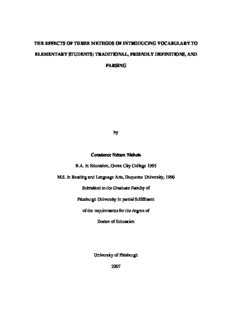Table Of ContentTHE EFFECTS OF THREE METHODS OF INTRODUCING VOCABULARY TO
ELEMENTARY STUDENTS: TRADITIONAL, FRIENDLY DEFINITIONS, AND
PARSING
by
Constance Nelson Nichols
B.A. in Education, Grove City College 1993
M.S. in Reading and Language Arts, Duquesne University, 1996
Submitted to the Graduate Faculty of
Pittsburgh University in partial fulfillment
of the requirements for the degree of
Doctor of Education
University of Pittsburgh
2007
UNIVERSITY OF PITTSBURGH
SCHOOL OF EDUCATION
This defense of a dissertation was presented
by
Constance Nelson Nichols
It was defended on
April 6, 2007
to
Dr. Rita Bean, Professor, School of Education
Dr. Louis Pingel, Professor, School of Education
Dr. Linda Kucan, Assistant Professor, School of Education
Dr. Isabel Beck: Dissertation Advisor, Professor, School of Education
ii
Copyright ©2007,
By Constance Nichols
iii
THE EFFECTS OF THREE METHODS OF INTRODUCING ELEMENTARY
STUDENTS VOCABULARY: TRADITONAL, FRIENDLY DEFINITIONS AND
PARSING
Constance Nelson Nichols
University of Pittsburgh, 2007
This study investigated the effects of three different approaches to vocabulary instruction
on students’ ability to learn initial meanings of new words: traditional definitions,
friendly definitions, and parsing. Fourth and fifth grade students enrolled in a rural
elementary school were introduced to new vocabulary terms in traditional, friendly
definitions, and parsing conditions. Tasks to assess students understanding of the new
terms included sentence generation, and responses to open ended questions about each
term.
Results indicated that across all three conditions no significant differences were
found for sentence generation tasks. For open ended question tasks differences were
found indicating students performed significantly better with traditional and friendly
definitions than parsing. Qualitative analysis indicated that parsing was not only
inadequate, but detrimental to learning new words from definitions.
It was hypothesized that the design of the study may have influenced results.
Implications for instruction and further research were discussed.
iv
TABLE OF CONTENTS
Preface………………………………………………………………………….. xii
1.0 Introduction…………………………………………………………….. 1
1.1 Rationale ………………………………………………………….. 2
1.2 Theoretical Background ………………………………………..... 3
1.2.1 Research related to vocabulary learning………………... 3
1.2.2 Active engagement in text comprehension……………… 5
1.3 Question addressed by this study……………… ……………….. 7
2.0 Review of Literature…………………………………………………….... 8
2.1 The relationship between comprehension and vocabulary......... 9
2.1.1 Empirical evidence………………………………………... 10
2.1.2 Theoretical perspectives………………………………….. 11
2.2 Vocabulary instruction…………………………………………… 14
2.2.1 Context vs. direct Instruction approaches……………….14
2.2.2 Recommended instructional approaches………………... 15
2.2.3 Typical classroom practices……………………………… 17
2.2.4 Definitions as a vehicle to learn new words…….……….. 19
v
2.2.4.1 Characteristic Features of Definitions…………... 19
2.2.4.2 Reader Characteristics…………………………… .21
2.3 Instruction Addressing Features of definitions and Active
Engagement……………………………………………………….. .22
2.3.1 Studies aimed at overcoming problematic features of
definitions…………………………………………………. .22
2.3.2 Issues about active engagement………………………….. .23
2.3.2.1 Active engagement through social collaboration.. .24
2.3.2.2 Active engagement and comprehension………… .25
3.0 Overview of Study……………………………………………………….... .29
3.1 Methods……………………………………………………………. .30
3.1.1 Context…………………………………………………….. .30
3.1.1.1 Study Participants………………………………….30
3.1.1.2 Selection of Words………………………………….34
3.1.1.3 Development of Parsing approach………………. .37
3.1.2 Articulation of Instructional Approaches and
Conditions…………………………………………………. .40
3.2 Procedures…………………………………………………………..43
3.2.1 Overall procedures……………………………………….. .43
3.2.2 Procedures…………………………………………………..44
3.2.2.1 Instruction to students……………………………..44
3.2.2.2 Procedures and materials………………………….45
3.3 Measures……………………………………………………………46
vi
3.3.1 Tasks………………………………………………………..46
3.4 Scoring of tasks and Data Analysis……………………………….47
3.4.1 Scoring of tasks…………………………………………….47
3.4.1.1 Sentence generation tasks………………………....47
3.4.1.2 Open ended question tasks…………………………50
3.4.2 Data Analysis.............……………………………………….52
4.0 Results……………………………………………………………………….54
4.1 Introduction…………………………………………………………54
4.2 Quantitative Results………………………………………………..55
4.2.1 Sentence generation tasks………………………………….55
4.2.2 Open ended question tasks…………………………………64
4.2.3 Summary of Quantitative Analysis……………………….68
4.3 Qualitative Analysis………………………………………………..69
5.0 Discussion…………………………………………………………………..84
5.1 Introduction………………………………………………………..84
5.2 Major Findings and Related Questions…………………………..84
5.2.1 Why were there no significant differences between
traditional definitions versus Friendly definitions?..........85
5.2.2 Why did the Parsing conditions fail to assist students in
learning new words?...........………………………………..86
5.2.3 Why was the sentence generation task an unreliable
measure?...............................................................................88
5.3 Implications………………………………………………………...92
vii
5.3.1 Implications for Research ………………………………...92
5.3.1.1 Issues related to vocabulary tasks………………..93
5.3.1.2 Issues related to study design……………………..93
5.3.2 Implications for Instruction………………………………94
APPENDIX A
IRB Approvals……………….……………………………………………95
APPENDIX B
Letters…………………………………………………………………….99
APPENDIX C
Word Selection Documents……………………………………………..117
APPENDIX D
Transcripts……………………………………………………………………....149
REFERENCES…………………………………………………………………166
viii
LIST OF TABLES
Table 1. Parsing Example………………………………….. …………………………..6
Table 2. Study phases and school participation………………………………………31
Table 3. PSSA scaled scores…………………………………………………….. ……33
Table 4. Example from pretest………………………………………………………...37
Table 5. Parsing queries and Responses………………………………………………39
Table 6. Scoring: Sentence Generation Task:… ……………………………….........48
Table 7. Examples of Open Ended Question Categories……………………….........51
Table 8. Sentence Generation Mean Scores by Condition and Grade Level……….57
Table 9. ANOVA Summary Table: Sentence Generation Task Full, Partial, Vague,
and Unacceptable………………………………….. ……………………………….58
Table 10. Means and Standard Deviations, Sentence Generation Tasks…………...60
Table 11. ANOVA Summary Table: Sentence Generation Task Full-Partial,
Vague Unacceptable…………………………………………………………….61
Table 12. Sentence Generation Examples of Full and Vague Responses…………...63
Table 13. Open Ended Questions Mean Scores by condition and grade level……...65
Table 14. ANOVA Summary Table: Open Ended Question Task……………..…...66
Table 15. Question Answer Exchanges………………………………………………..71
ix
Table 16. Exchanges in Parsing………………………………………………………..74
Table 17. Answers to Open Ended Questions, “altercation” ………………………..76
Table 18. Answers to Open Ended Questions, “altercation” ………………………..78
Table 19. Answers to Open Ended Questions, “devious” …………………………...80
Table 20. Answers to Open Ended Questions, “eminence” …………………………82
Table 21. Example Student Answers and scores for sentence generation tasks and
open ended questions................……………………………………………………. 91
x
Description:When you play Pictionary. You can allude something when you are playing the game “I Spy”. When they can't find something Words by condition. Traditional. Presented during week 1 of study affluent amicable comply copious dearth deviate explicit infallible liberate prominent succulent trivial. 1

